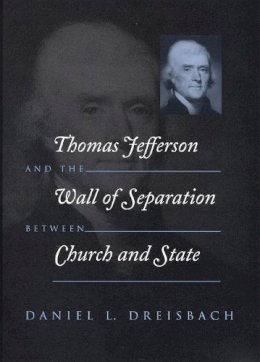
Thomas Jefferson and the Wall of Separation between Church and State
Daniel Dreisbach
The origins, controversial uses, and competing interpretations of Jefferson's famous remark—"wall of separation between church and state"
No phrase in American letters has had a more profound influence on church-state law, policy, and discourse than Thomas Jefferson’s “wall of separation between church and state,” and few metaphors have provoked more passionate debate. Introduced in an 1802 letter to the Danbury, Connecticut Baptist Association, Jefferson’s “wall” is accepted by many Americans as a concise description of the U.S. Constitution’s church-state arrangement and conceived as a virtual rule of constitutional law.
Despite the enormous influence of the “wall” metaphor, almost no scholarship has investigated the text of the Danbury letter, the context in which it was written, or Jefferson’s understanding of his famous phrase. Thomas Jefferson and the Wall of Separation Between Church and State offers an in-depth examination of the origins, controversial uses, and competing interpretations of this powerful metaphor in law and public policy.
Product Details
About Daniel Dreisbach
Reviews for Thomas Jefferson and the Wall of Separation between Church and State
Faith and Mission
"Daniel Dreisbachs book is a welcome and much needed addition to the scholarship on the First Amendment. Dreisbach analysis of Jefferson's metaphor, its political context, and consequences for church-state jurisprudence, provide an intellectual perspective as the Court and nation reconsider issues of accomodations of religion in the public square."
Journal of Interdisciplinary Studies
"On an evaluative note, the book is helpful for gaining an understanding of the historical context of Jeffersons metaphor."
Journal of Church and State
"This book is vintage Dreisbach. . . . Anyone studying Jefferson's views of separation would be wise to use Dreisbachs primary texts and to ponder his sage interpretation of them. This is a book that can be read in an evening, but pondered for a career."
John Witte Jr.,Michigan Law Review "Excellent introduction to the thorny interpretive issues that continue to grow around Jefferson's wall."
The Journal of Southern History
